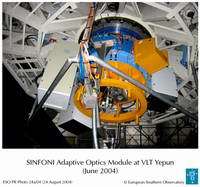SINFONI Opens With Upbeat Chords

ESO's Very Large Telescope welcomes the first ever adaptive optics assisted spectrograph on an 8-m class telescope: SINFONI. During the successful commissioning of the Adaptive Optics Module, exceptional images were obtained of main-belt asteroid Kalliope and its moon. Following the "First Light" spectrum, the SINFONI instrument made test observations on a selection of exciting astronomical targets, among which unprecedented high-angular resolution spectra and images of stars around the massive black hole in the Galactic Centre.
The European Southern Observatory, the Max-Planck-Institute for Extraterrestrial Physics (Garching, Germany) and the Nederlandse Onderzoekschool Voor Astronomie (Leiden, The Netherlands), and with them all European astronomers, are celebrating the successful accomplishment of "First Light" for the Adaptive Optics (AO) assisted SINFONI ("Spectrograph for INtegral Field Observation in the Near-Infrared") instrument, just installed on ESO's Very Large Telescope at the Paranal Observatory (Chile).
This is the first facility of its type ever installed on an 8-m class telescope, now providing exceptional observing capabilities for the imaging and spectroscopic studies of very complex sky regions, e.g. stellar nurseries and black-hole environments, also in distant galaxies.
Following smooth assembly at the 8.2-m VLT Yepun telescope of SINFONI's two parts, the Adaptive Optics Module that feeds the SPIFFI spectrograph, the "First Light" spectrum of a bright star was recorded with SINFONI in the early evening of July 9, 2004.
The following thirteen nights served to evaluate the performance of the new instrument and to explore its capabilities by test observations on a selection of exciting astronomical targets. They included the Galactic Centre region, already imaged with the NACO AO-instrument on the same telescope. Unprecedented high-angular resolution spectra and images were obtained of stars in the immediate vicinity of the massive central black hole. During the night of July 15 - 16, SINFONI recorded a flare from this black hole in great detail.
Other interesting objects observed during this period include galaxies with active nuclei (e.g., the Circinus Galaxy and NGC 7469), a merging galaxy system (NGC 6240) and a young starforming galaxy pair at redshift 2 (BX 404/405).
These first results were greeted with enthusiasm by the team of astronomers and engineers [2] from the consortium of German and Dutch Institutes and ESO who have worked on the development of SINFONI for nearly 7 years.
The work on SINFONI at Paranal included successful commissioning in June 2004 of the Adaptive Optics Module built by ESO, during which exceptional test images were obtained of the main-belt asteroid (22) Kalliope and its moon. Moreover, the ability was demonstrated to correct the atmospheric turbulence by means of even very faint "guide" objects (magnitude 17.5), crucial for the observation of astronomical objects in many parts of the sky.
SPIFFI - SPectrometer for Infrared Faint Field Imaging - was developed at the Max Planck Institute for Extraterrestrische Physik (MPE) in Garching (Germany), in a collaboration with the Nederlandse Onderzoekschool Voor Astronomie (NOVA) in Leiden and the Netherlands Foundation for Research in Astronomy (ASTRON), and ESO.
Source: ESO
Related link: www.eso.org/outreach/press-rel … r-2004/pr-21-04.html



















